Industrial Dispute: SPC Ardmona Case Study Analysis, University XYZ
VerifiedAdded on 2019/10/31
|18
|4101
|483
Report
AI Summary
This report provides a detailed analysis of the industrial dispute at SPC Ardmona, a major fruit processing company in Australia. It begins by defining industrial disputes, classifying them, and outlining the forms they take, such as picketing, boycotts, and strikes. The report delves into the factors that contributed to the dispute, including economic challenges like cheap imports, recession in the business, price wars, workforce layoffs, and the withdrawal of contracts. It examines the perspectives of the federal government, employers, and workers/unions, highlighting their concerns and strategies. The report then explores the outcomes of the dispute, the tactics used, and the resolution process, including the restructuring of the enterprise bargaining agreement. Finally, it offers an opinion on the effectiveness of the resolution, making this paper a valuable resource for understanding industrial relations and business development.
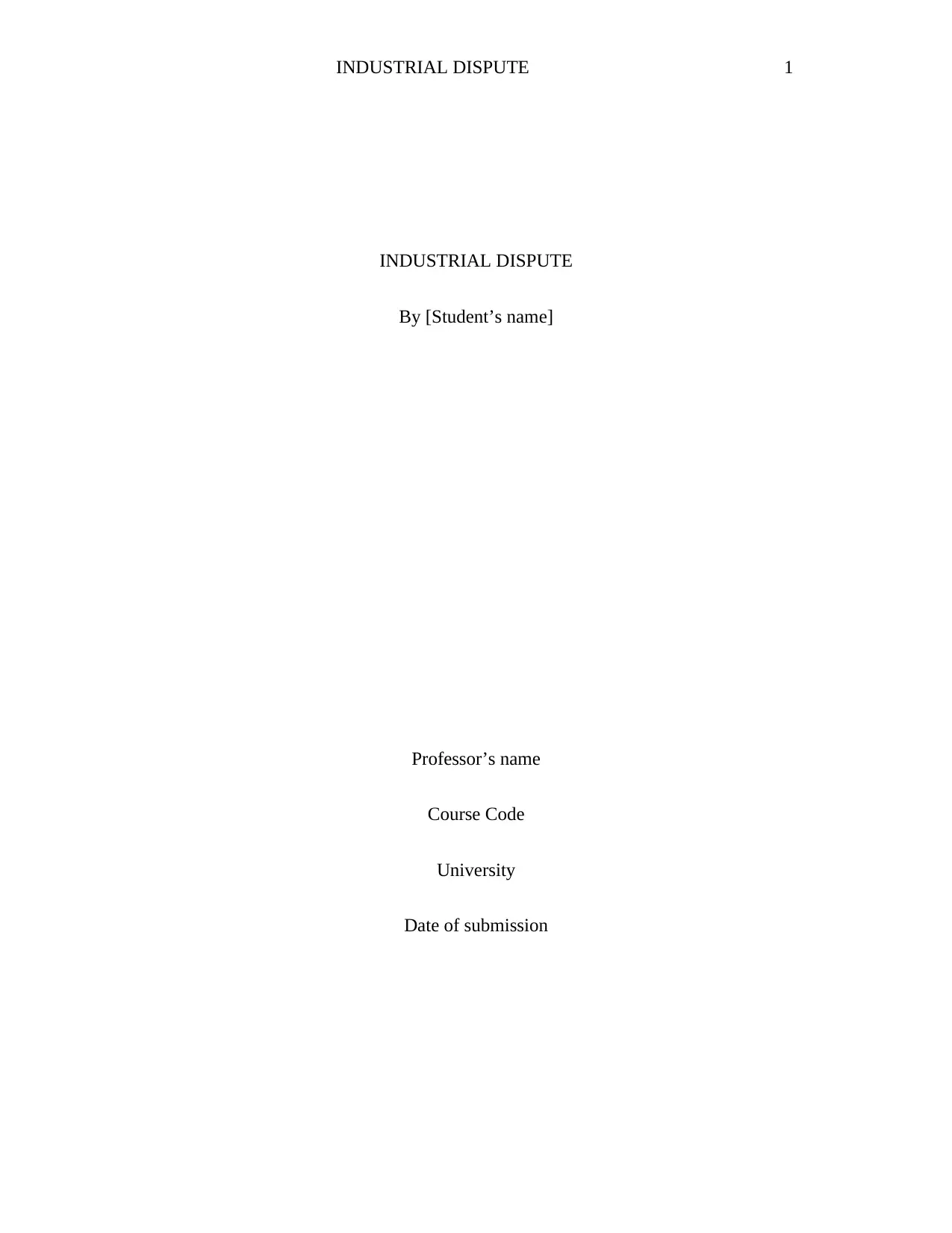
INDUSTRIAL DISPUTE 1
INDUSTRIAL DISPUTE
By [Student’s name]
Professor’s name
Course Code
University
Date of submission
INDUSTRIAL DISPUTE
By [Student’s name]
Professor’s name
Course Code
University
Date of submission
Paraphrase This Document
Need a fresh take? Get an instant paraphrase of this document with our AI Paraphraser
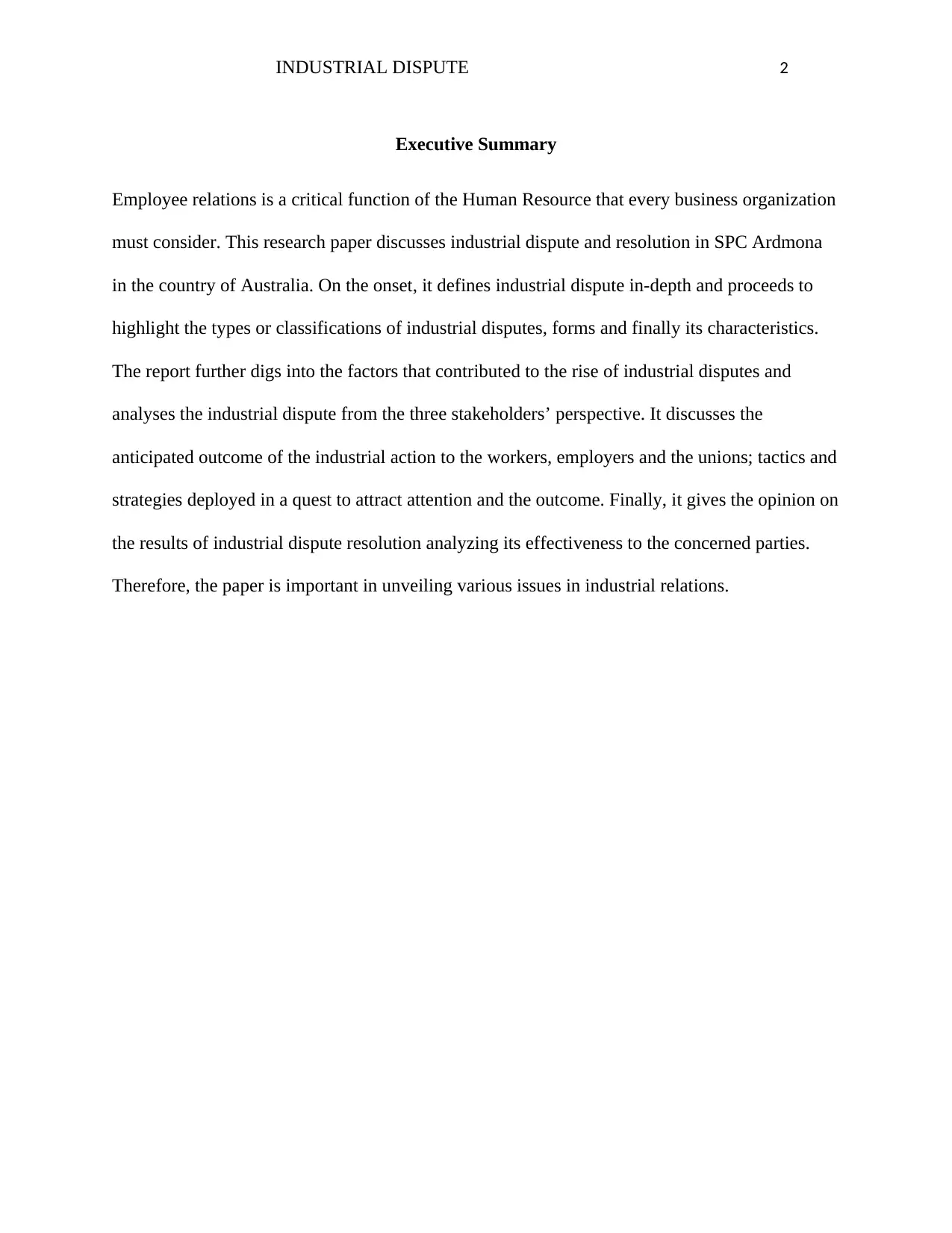
INDUSTRIAL DISPUTE 2
Executive Summary
Employee relations is a critical function of the Human Resource that every business organization
must consider. This research paper discusses industrial dispute and resolution in SPC Ardmona
in the country of Australia. On the onset, it defines industrial dispute in-depth and proceeds to
highlight the types or classifications of industrial disputes, forms and finally its characteristics.
The report further digs into the factors that contributed to the rise of industrial disputes and
analyses the industrial dispute from the three stakeholders’ perspective. It discusses the
anticipated outcome of the industrial action to the workers, employers and the unions; tactics and
strategies deployed in a quest to attract attention and the outcome. Finally, it gives the opinion on
the results of industrial dispute resolution analyzing its effectiveness to the concerned parties.
Therefore, the paper is important in unveiling various issues in industrial relations.
Executive Summary
Employee relations is a critical function of the Human Resource that every business organization
must consider. This research paper discusses industrial dispute and resolution in SPC Ardmona
in the country of Australia. On the onset, it defines industrial dispute in-depth and proceeds to
highlight the types or classifications of industrial disputes, forms and finally its characteristics.
The report further digs into the factors that contributed to the rise of industrial disputes and
analyses the industrial dispute from the three stakeholders’ perspective. It discusses the
anticipated outcome of the industrial action to the workers, employers and the unions; tactics and
strategies deployed in a quest to attract attention and the outcome. Finally, it gives the opinion on
the results of industrial dispute resolution analyzing its effectiveness to the concerned parties.
Therefore, the paper is important in unveiling various issues in industrial relations.
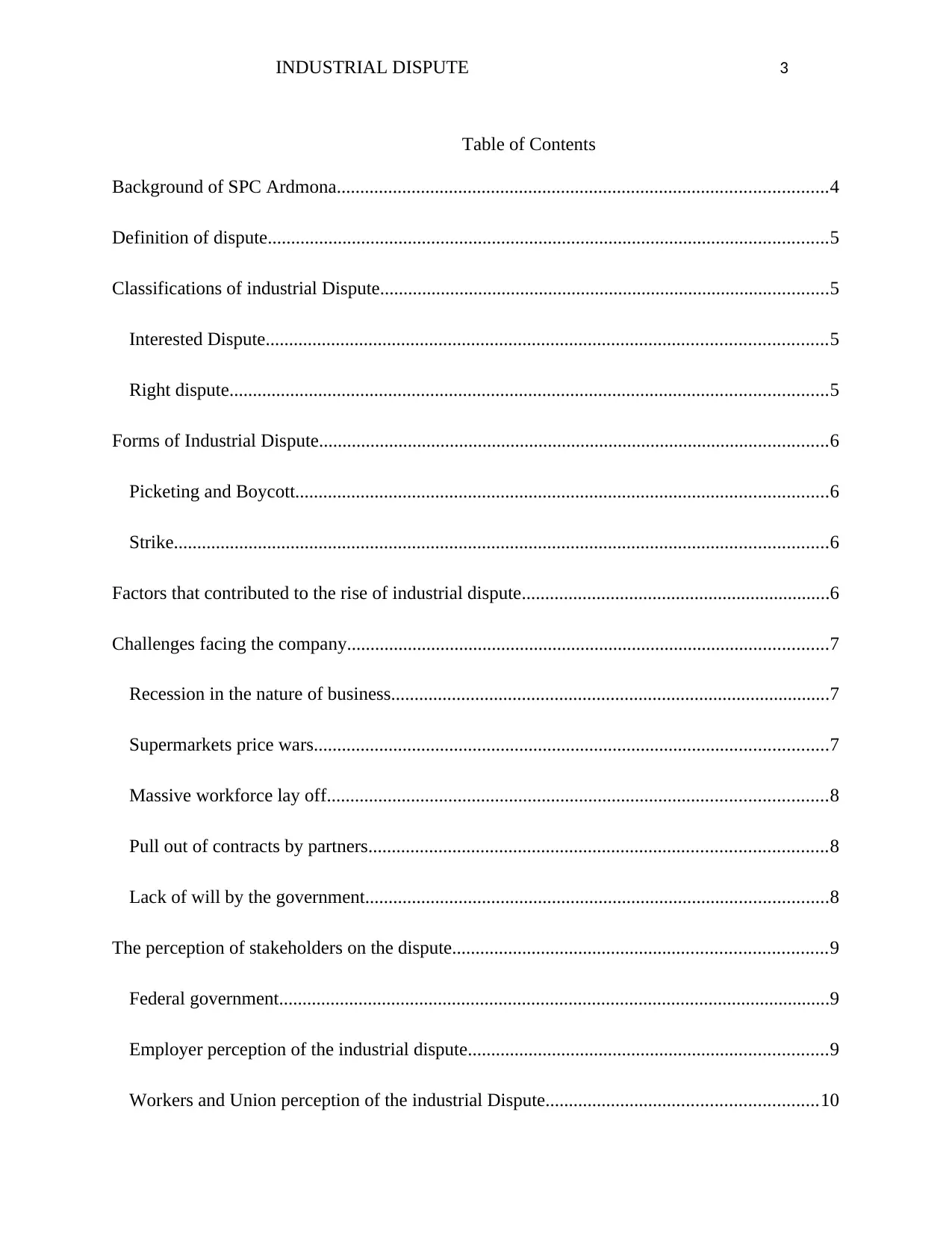
INDUSTRIAL DISPUTE 3
Table of Contents
Background of SPC Ardmona.........................................................................................................4
Definition of dispute........................................................................................................................5
Classifications of industrial Dispute................................................................................................5
Interested Dispute........................................................................................................................5
Right dispute................................................................................................................................5
Forms of Industrial Dispute.............................................................................................................6
Picketing and Boycott..................................................................................................................6
Strike............................................................................................................................................6
Factors that contributed to the rise of industrial dispute..................................................................6
Challenges facing the company.......................................................................................................7
Recession in the nature of business..............................................................................................7
Supermarkets price wars..............................................................................................................7
Massive workforce lay off...........................................................................................................8
Pull out of contracts by partners..................................................................................................8
Lack of will by the government...................................................................................................8
The perception of stakeholders on the dispute................................................................................9
Federal government......................................................................................................................9
Employer perception of the industrial dispute.............................................................................9
Workers and Union perception of the industrial Dispute..........................................................10
Table of Contents
Background of SPC Ardmona.........................................................................................................4
Definition of dispute........................................................................................................................5
Classifications of industrial Dispute................................................................................................5
Interested Dispute........................................................................................................................5
Right dispute................................................................................................................................5
Forms of Industrial Dispute.............................................................................................................6
Picketing and Boycott..................................................................................................................6
Strike............................................................................................................................................6
Factors that contributed to the rise of industrial dispute..................................................................6
Challenges facing the company.......................................................................................................7
Recession in the nature of business..............................................................................................7
Supermarkets price wars..............................................................................................................7
Massive workforce lay off...........................................................................................................8
Pull out of contracts by partners..................................................................................................8
Lack of will by the government...................................................................................................8
The perception of stakeholders on the dispute................................................................................9
Federal government......................................................................................................................9
Employer perception of the industrial dispute.............................................................................9
Workers and Union perception of the industrial Dispute..........................................................10
⊘ This is a preview!⊘
Do you want full access?
Subscribe today to unlock all pages.

Trusted by 1+ million students worldwide
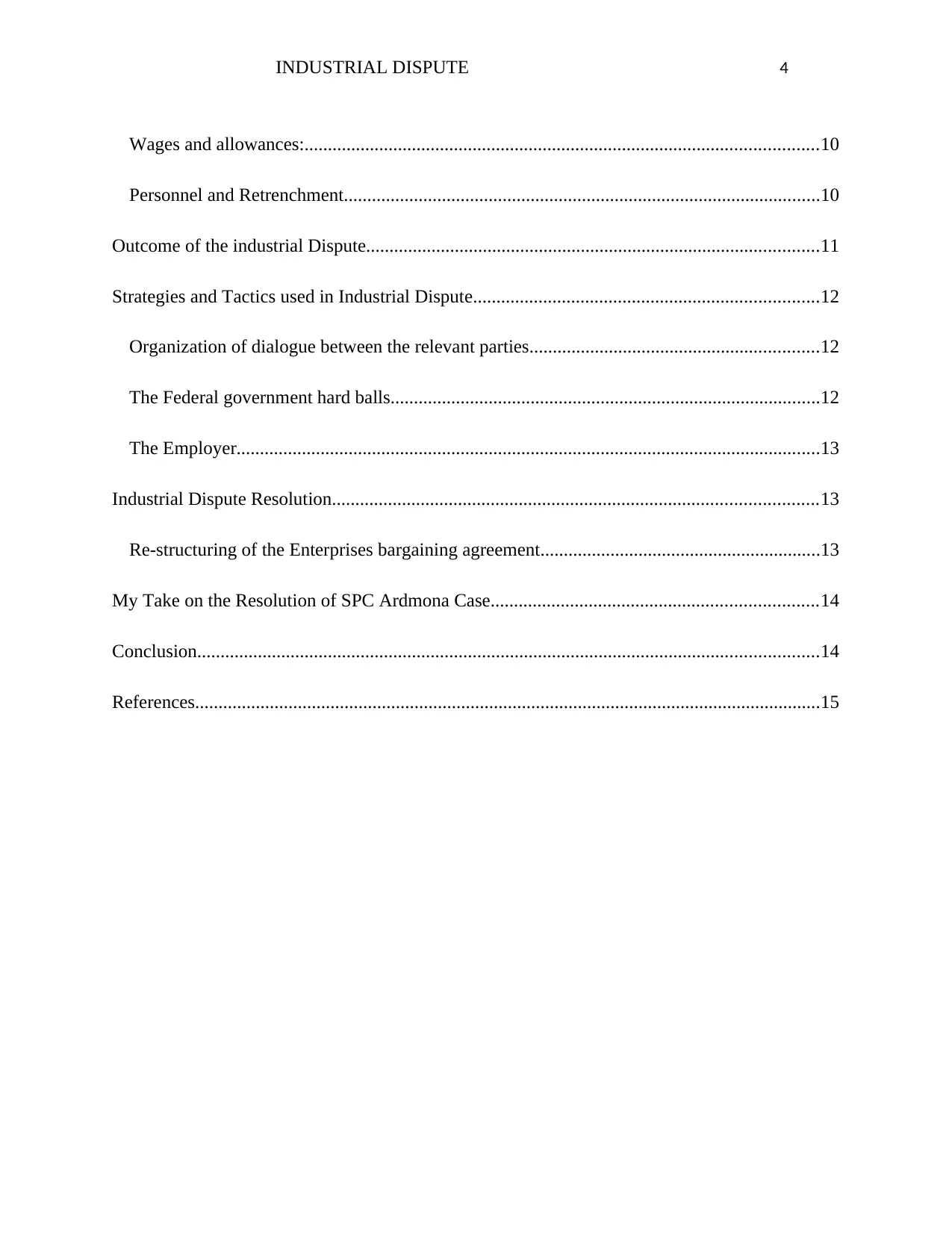
INDUSTRIAL DISPUTE 4
Wages and allowances:..............................................................................................................10
Personnel and Retrenchment......................................................................................................10
Outcome of the industrial Dispute.................................................................................................11
Strategies and Tactics used in Industrial Dispute..........................................................................12
Organization of dialogue between the relevant parties..............................................................12
The Federal government hard balls............................................................................................12
The Employer.............................................................................................................................13
Industrial Dispute Resolution........................................................................................................13
Re-structuring of the Enterprises bargaining agreement............................................................13
My Take on the Resolution of SPC Ardmona Case......................................................................14
Conclusion.....................................................................................................................................14
References......................................................................................................................................15
Wages and allowances:..............................................................................................................10
Personnel and Retrenchment......................................................................................................10
Outcome of the industrial Dispute.................................................................................................11
Strategies and Tactics used in Industrial Dispute..........................................................................12
Organization of dialogue between the relevant parties..............................................................12
The Federal government hard balls............................................................................................12
The Employer.............................................................................................................................13
Industrial Dispute Resolution........................................................................................................13
Re-structuring of the Enterprises bargaining agreement............................................................13
My Take on the Resolution of SPC Ardmona Case......................................................................14
Conclusion.....................................................................................................................................14
References......................................................................................................................................15
Paraphrase This Document
Need a fresh take? Get an instant paraphrase of this document with our AI Paraphraser
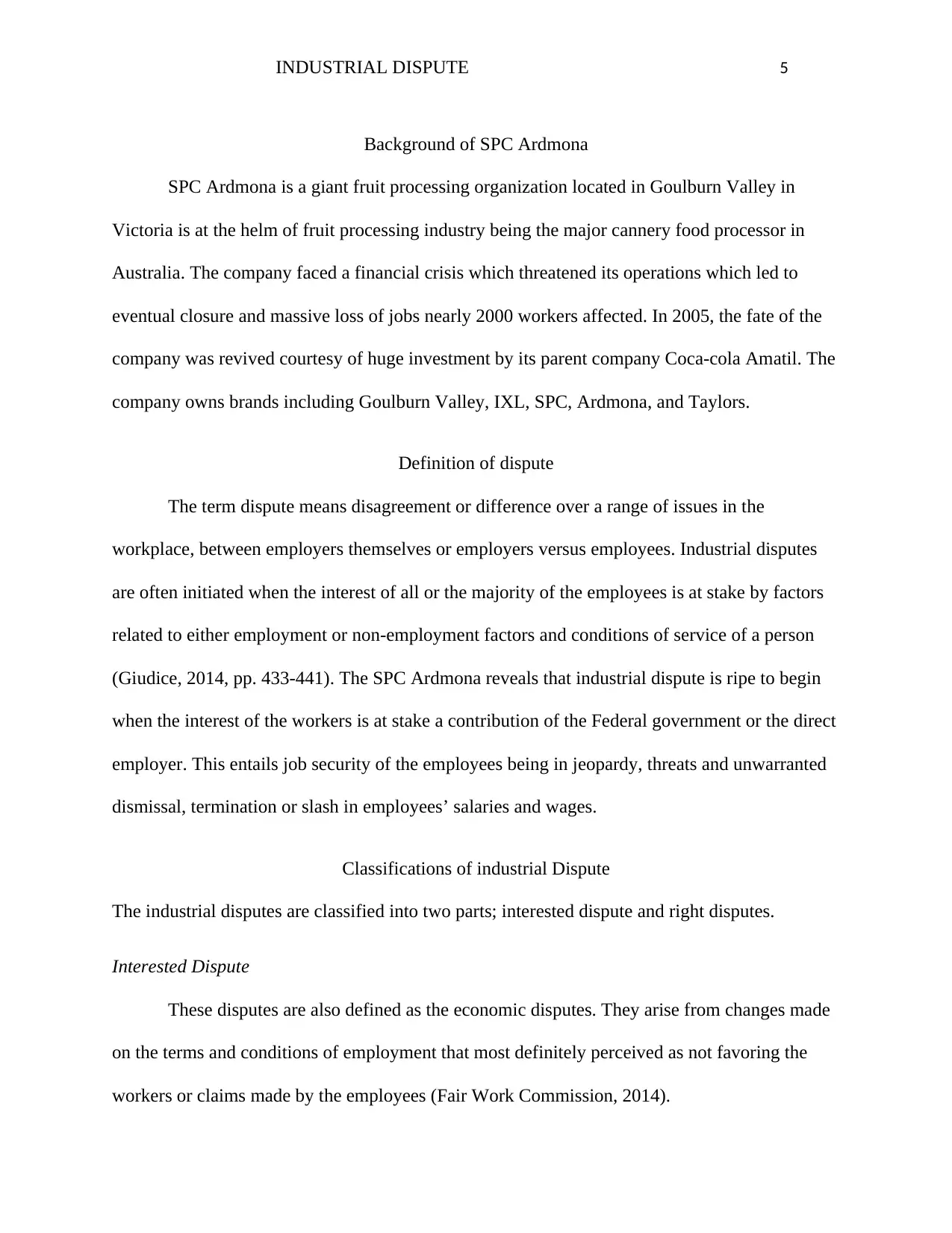
INDUSTRIAL DISPUTE 5
Background of SPC Ardmona
SPC Ardmona is a giant fruit processing organization located in Goulburn Valley in
Victoria is at the helm of fruit processing industry being the major cannery food processor in
Australia. The company faced a financial crisis which threatened its operations which led to
eventual closure and massive loss of jobs nearly 2000 workers affected. In 2005, the fate of the
company was revived courtesy of huge investment by its parent company Coca-cola Amatil. The
company owns brands including Goulburn Valley, IXL, SPC, Ardmona, and Taylors.
Definition of dispute
The term dispute means disagreement or difference over a range of issues in the
workplace, between employers themselves or employers versus employees. Industrial disputes
are often initiated when the interest of all or the majority of the employees is at stake by factors
related to either employment or non-employment factors and conditions of service of a person
(Giudice, 2014, pp. 433-441). The SPC Ardmona reveals that industrial dispute is ripe to begin
when the interest of the workers is at stake a contribution of the Federal government or the direct
employer. This entails job security of the employees being in jeopardy, threats and unwarranted
dismissal, termination or slash in employees’ salaries and wages.
Classifications of industrial Dispute
The industrial disputes are classified into two parts; interested dispute and right disputes.
Interested Dispute
These disputes are also defined as the economic disputes. They arise from changes made
on the terms and conditions of employment that most definitely perceived as not favoring the
workers or claims made by the employees (Fair Work Commission, 2014).
Background of SPC Ardmona
SPC Ardmona is a giant fruit processing organization located in Goulburn Valley in
Victoria is at the helm of fruit processing industry being the major cannery food processor in
Australia. The company faced a financial crisis which threatened its operations which led to
eventual closure and massive loss of jobs nearly 2000 workers affected. In 2005, the fate of the
company was revived courtesy of huge investment by its parent company Coca-cola Amatil. The
company owns brands including Goulburn Valley, IXL, SPC, Ardmona, and Taylors.
Definition of dispute
The term dispute means disagreement or difference over a range of issues in the
workplace, between employers themselves or employers versus employees. Industrial disputes
are often initiated when the interest of all or the majority of the employees is at stake by factors
related to either employment or non-employment factors and conditions of service of a person
(Giudice, 2014, pp. 433-441). The SPC Ardmona reveals that industrial dispute is ripe to begin
when the interest of the workers is at stake a contribution of the Federal government or the direct
employer. This entails job security of the employees being in jeopardy, threats and unwarranted
dismissal, termination or slash in employees’ salaries and wages.
Classifications of industrial Dispute
The industrial disputes are classified into two parts; interested dispute and right disputes.
Interested Dispute
These disputes are also defined as the economic disputes. They arise from changes made
on the terms and conditions of employment that most definitely perceived as not favoring the
workers or claims made by the employees (Fair Work Commission, 2014).
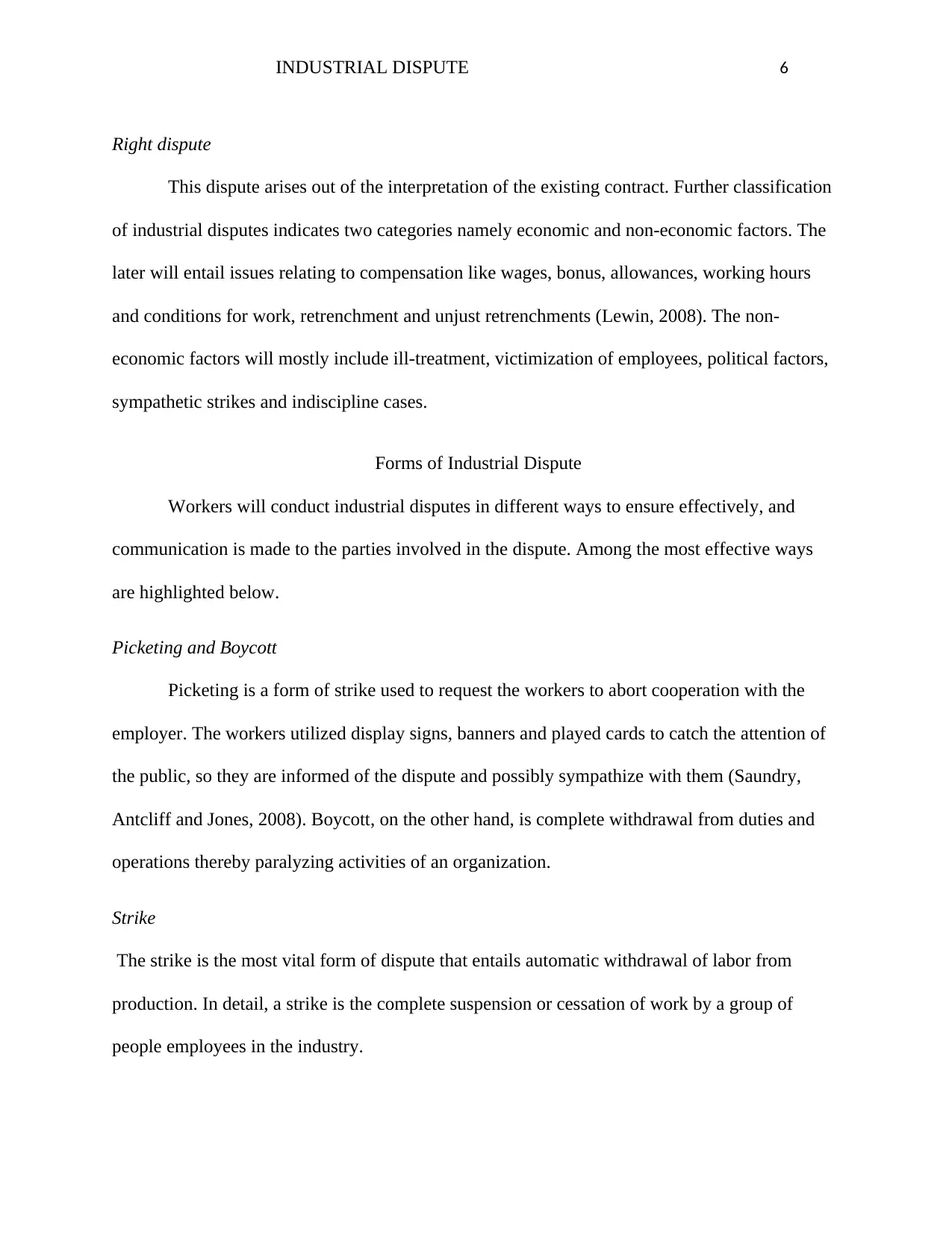
INDUSTRIAL DISPUTE 6
Right dispute
This dispute arises out of the interpretation of the existing contract. Further classification
of industrial disputes indicates two categories namely economic and non-economic factors. The
later will entail issues relating to compensation like wages, bonus, allowances, working hours
and conditions for work, retrenchment and unjust retrenchments (Lewin, 2008). The non-
economic factors will mostly include ill-treatment, victimization of employees, political factors,
sympathetic strikes and indiscipline cases.
Forms of Industrial Dispute
Workers will conduct industrial disputes in different ways to ensure effectively, and
communication is made to the parties involved in the dispute. Among the most effective ways
are highlighted below.
Picketing and Boycott
Picketing is a form of strike used to request the workers to abort cooperation with the
employer. The workers utilized display signs, banners and played cards to catch the attention of
the public, so they are informed of the dispute and possibly sympathize with them (Saundry,
Antcliff and Jones, 2008). Boycott, on the other hand, is complete withdrawal from duties and
operations thereby paralyzing activities of an organization.
Strike
The strike is the most vital form of dispute that entails automatic withdrawal of labor from
production. In detail, a strike is the complete suspension or cessation of work by a group of
people employees in the industry.
Right dispute
This dispute arises out of the interpretation of the existing contract. Further classification
of industrial disputes indicates two categories namely economic and non-economic factors. The
later will entail issues relating to compensation like wages, bonus, allowances, working hours
and conditions for work, retrenchment and unjust retrenchments (Lewin, 2008). The non-
economic factors will mostly include ill-treatment, victimization of employees, political factors,
sympathetic strikes and indiscipline cases.
Forms of Industrial Dispute
Workers will conduct industrial disputes in different ways to ensure effectively, and
communication is made to the parties involved in the dispute. Among the most effective ways
are highlighted below.
Picketing and Boycott
Picketing is a form of strike used to request the workers to abort cooperation with the
employer. The workers utilized display signs, banners and played cards to catch the attention of
the public, so they are informed of the dispute and possibly sympathize with them (Saundry,
Antcliff and Jones, 2008). Boycott, on the other hand, is complete withdrawal from duties and
operations thereby paralyzing activities of an organization.
Strike
The strike is the most vital form of dispute that entails automatic withdrawal of labor from
production. In detail, a strike is the complete suspension or cessation of work by a group of
people employees in the industry.
⊘ This is a preview!⊘
Do you want full access?
Subscribe today to unlock all pages.

Trusted by 1+ million students worldwide
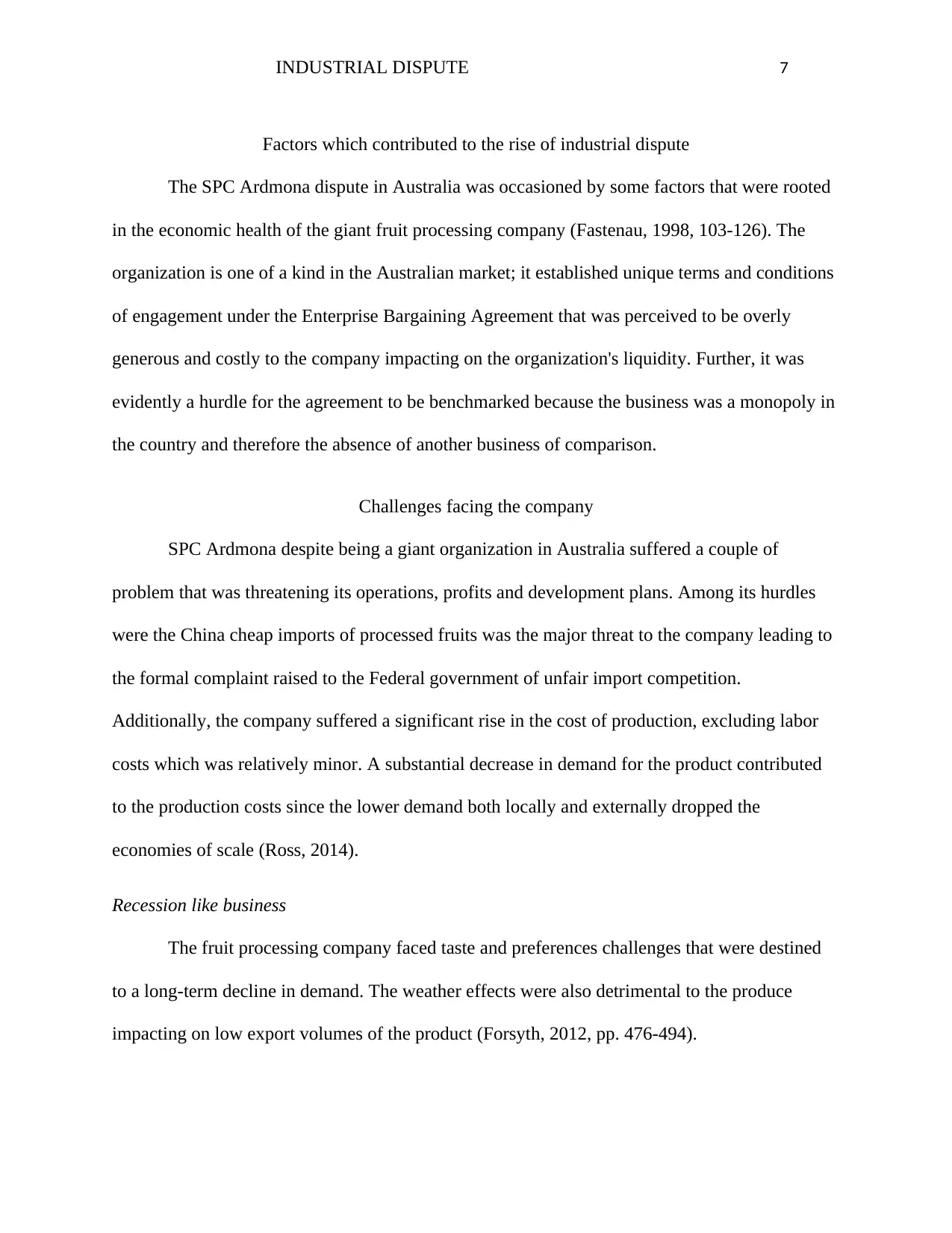
INDUSTRIAL DISPUTE 7
Factors which contributed to the rise of industrial dispute
The SPC Ardmona dispute in Australia was occasioned by some factors that were rooted
in the economic health of the giant fruit processing company (Fastenau, 1998, 103-126). The
organization is one of a kind in the Australian market; it established unique terms and conditions
of engagement under the Enterprise Bargaining Agreement that was perceived to be overly
generous and costly to the company impacting on the organization's liquidity. Further, it was
evidently a hurdle for the agreement to be benchmarked because the business was a monopoly in
the country and therefore the absence of another business of comparison.
Challenges facing the company
SPC Ardmona despite being a giant organization in Australia suffered a couple of
problem that was threatening its operations, profits and development plans. Among its hurdles
were the China cheap imports of processed fruits was the major threat to the company leading to
the formal complaint raised to the Federal government of unfair import competition.
Additionally, the company suffered a significant rise in the cost of production, excluding labor
costs which was relatively minor. A substantial decrease in demand for the product contributed
to the production costs since the lower demand both locally and externally dropped the
economies of scale (Ross, 2014).
Recession like business
The fruit processing company faced taste and preferences challenges that were destined
to a long-term decline in demand. The weather effects were also detrimental to the produce
impacting on low export volumes of the product (Forsyth, 2012, pp. 476-494).
Factors which contributed to the rise of industrial dispute
The SPC Ardmona dispute in Australia was occasioned by some factors that were rooted
in the economic health of the giant fruit processing company (Fastenau, 1998, 103-126). The
organization is one of a kind in the Australian market; it established unique terms and conditions
of engagement under the Enterprise Bargaining Agreement that was perceived to be overly
generous and costly to the company impacting on the organization's liquidity. Further, it was
evidently a hurdle for the agreement to be benchmarked because the business was a monopoly in
the country and therefore the absence of another business of comparison.
Challenges facing the company
SPC Ardmona despite being a giant organization in Australia suffered a couple of
problem that was threatening its operations, profits and development plans. Among its hurdles
were the China cheap imports of processed fruits was the major threat to the company leading to
the formal complaint raised to the Federal government of unfair import competition.
Additionally, the company suffered a significant rise in the cost of production, excluding labor
costs which was relatively minor. A substantial decrease in demand for the product contributed
to the production costs since the lower demand both locally and externally dropped the
economies of scale (Ross, 2014).
Recession like business
The fruit processing company faced taste and preferences challenges that were destined
to a long-term decline in demand. The weather effects were also detrimental to the produce
impacting on low export volumes of the product (Forsyth, 2012, pp. 476-494).
Paraphrase This Document
Need a fresh take? Get an instant paraphrase of this document with our AI Paraphraser
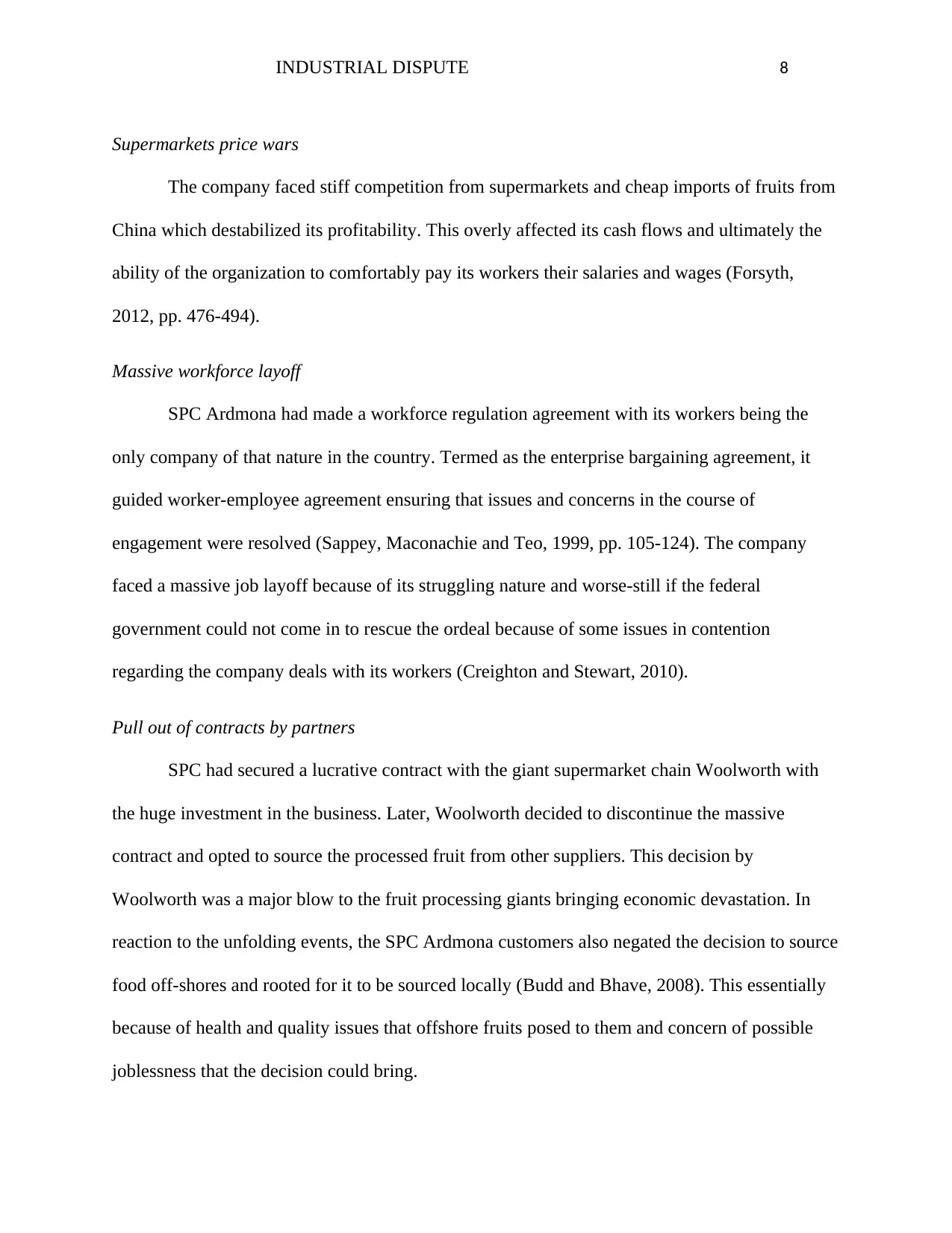
INDUSTRIAL DISPUTE 8
Supermarkets price wars
The company faced stiff competition from supermarkets and cheap imports of fruits from
China which destabilized its profitability. This overly affected its cash flows and ultimately the
ability of the organization to comfortably pay its workers their salaries and wages (Forsyth,
2012, pp. 476-494).
Massive workforce layoff
SPC Ardmona had made a workforce regulation agreement with its workers being the
only company of that nature in the country. Termed as the enterprise bargaining agreement, it
guided worker-employee agreement ensuring that issues and concerns in the course of
engagement were resolved (Sappey, Maconachie and Teo, 1999, pp. 105-124). The company
faced a massive job layoff because of its struggling nature and worse-still if the federal
government could not come in to rescue the ordeal because of some issues in contention
regarding the company deals with its workers (Creighton and Stewart, 2010).
Pull out of contracts by partners
SPC had secured a lucrative contract with the giant supermarket chain Woolworth with
the huge investment in the business. Later, Woolworth decided to discontinue the massive
contract and opted to source the processed fruit from other suppliers. This decision by
Woolworth was a major blow to the fruit processing giants bringing economic devastation. In
reaction to the unfolding events, the SPC Ardmona customers also negated the decision to source
food off-shores and rooted for it to be sourced locally (Budd and Bhave, 2008). This essentially
because of health and quality issues that offshore fruits posed to them and concern of possible
joblessness that the decision could bring.
Supermarkets price wars
The company faced stiff competition from supermarkets and cheap imports of fruits from
China which destabilized its profitability. This overly affected its cash flows and ultimately the
ability of the organization to comfortably pay its workers their salaries and wages (Forsyth,
2012, pp. 476-494).
Massive workforce layoff
SPC Ardmona had made a workforce regulation agreement with its workers being the
only company of that nature in the country. Termed as the enterprise bargaining agreement, it
guided worker-employee agreement ensuring that issues and concerns in the course of
engagement were resolved (Sappey, Maconachie and Teo, 1999, pp. 105-124). The company
faced a massive job layoff because of its struggling nature and worse-still if the federal
government could not come in to rescue the ordeal because of some issues in contention
regarding the company deals with its workers (Creighton and Stewart, 2010).
Pull out of contracts by partners
SPC had secured a lucrative contract with the giant supermarket chain Woolworth with
the huge investment in the business. Later, Woolworth decided to discontinue the massive
contract and opted to source the processed fruit from other suppliers. This decision by
Woolworth was a major blow to the fruit processing giants bringing economic devastation. In
reaction to the unfolding events, the SPC Ardmona customers also negated the decision to source
food off-shores and rooted for it to be sourced locally (Budd and Bhave, 2008). This essentially
because of health and quality issues that offshore fruits posed to them and concern of possible
joblessness that the decision could bring.
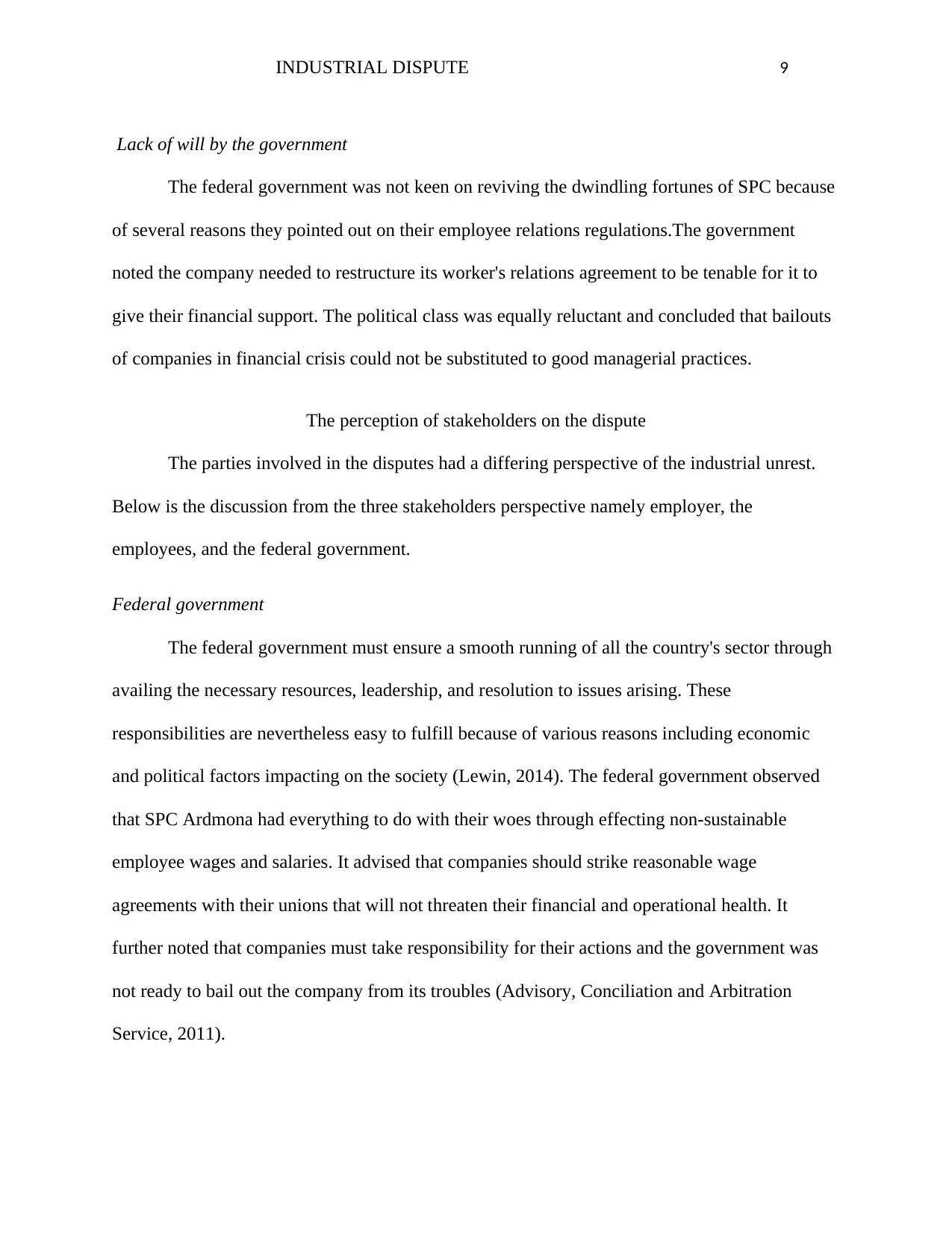
INDUSTRIAL DISPUTE 9
Lack of will by the government
The federal government was not keen on reviving the dwindling fortunes of SPC because
of several reasons they pointed out on their employee relations regulations.The government
noted the company needed to restructure its worker's relations agreement to be tenable for it to
give their financial support. The political class was equally reluctant and concluded that bailouts
of companies in financial crisis could not be substituted to good managerial practices.
The perception of stakeholders on the dispute
The parties involved in the disputes had a differing perspective of the industrial unrest.
Below is the discussion from the three stakeholders perspective namely employer, the
employees, and the federal government.
Federal government
The federal government must ensure a smooth running of all the country's sector through
availing the necessary resources, leadership, and resolution to issues arising. These
responsibilities are nevertheless easy to fulfill because of various reasons including economic
and political factors impacting on the society (Lewin, 2014). The federal government observed
that SPC Ardmona had everything to do with their woes through effecting non-sustainable
employee wages and salaries. It advised that companies should strike reasonable wage
agreements with their unions that will not threaten their financial and operational health. It
further noted that companies must take responsibility for their actions and the government was
not ready to bail out the company from its troubles (Advisory, Conciliation and Arbitration
Service, 2011).
Lack of will by the government
The federal government was not keen on reviving the dwindling fortunes of SPC because
of several reasons they pointed out on their employee relations regulations.The government
noted the company needed to restructure its worker's relations agreement to be tenable for it to
give their financial support. The political class was equally reluctant and concluded that bailouts
of companies in financial crisis could not be substituted to good managerial practices.
The perception of stakeholders on the dispute
The parties involved in the disputes had a differing perspective of the industrial unrest.
Below is the discussion from the three stakeholders perspective namely employer, the
employees, and the federal government.
Federal government
The federal government must ensure a smooth running of all the country's sector through
availing the necessary resources, leadership, and resolution to issues arising. These
responsibilities are nevertheless easy to fulfill because of various reasons including economic
and political factors impacting on the society (Lewin, 2014). The federal government observed
that SPC Ardmona had everything to do with their woes through effecting non-sustainable
employee wages and salaries. It advised that companies should strike reasonable wage
agreements with their unions that will not threaten their financial and operational health. It
further noted that companies must take responsibility for their actions and the government was
not ready to bail out the company from its troubles (Advisory, Conciliation and Arbitration
Service, 2011).
⊘ This is a preview!⊘
Do you want full access?
Subscribe today to unlock all pages.

Trusted by 1+ million students worldwide
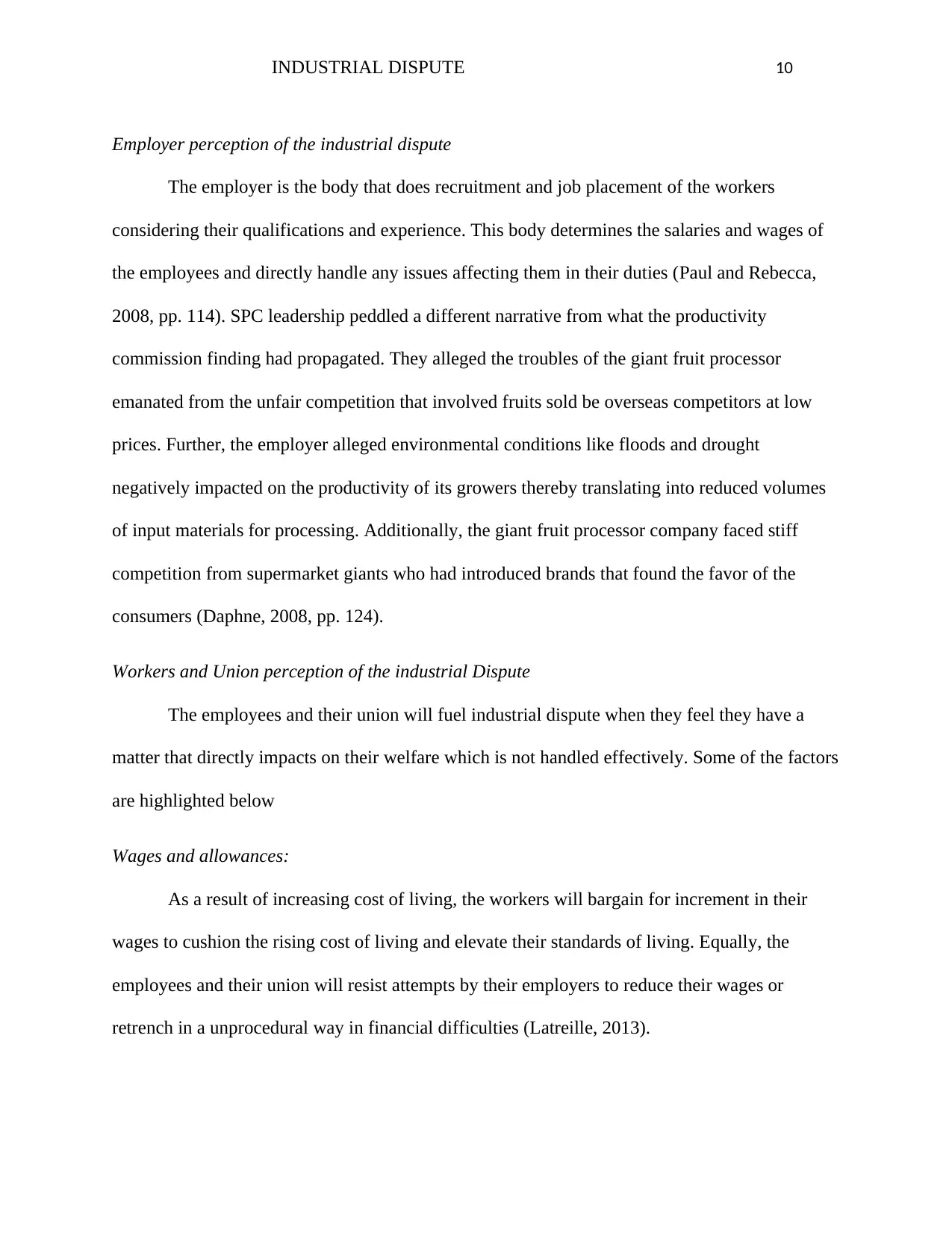
INDUSTRIAL DISPUTE 10
Employer perception of the industrial dispute
The employer is the body that does recruitment and job placement of the workers
considering their qualifications and experience. This body determines the salaries and wages of
the employees and directly handle any issues affecting them in their duties (Paul and Rebecca,
2008, pp. 114). SPC leadership peddled a different narrative from what the productivity
commission finding had propagated. They alleged the troubles of the giant fruit processor
emanated from the unfair competition that involved fruits sold be overseas competitors at low
prices. Further, the employer alleged environmental conditions like floods and drought
negatively impacted on the productivity of its growers thereby translating into reduced volumes
of input materials for processing. Additionally, the giant fruit processor company faced stiff
competition from supermarket giants who had introduced brands that found the favor of the
consumers (Daphne, 2008, pp. 124).
Workers and Union perception of the industrial Dispute
The employees and their union will fuel industrial dispute when they feel they have a
matter that directly impacts on their welfare which is not handled effectively. Some of the factors
are highlighted below
Wages and allowances:
As a result of increasing cost of living, the workers will bargain for increment in their
wages to cushion the rising cost of living and elevate their standards of living. Equally, the
employees and their union will resist attempts by their employers to reduce their wages or
retrench in a unprocedural way in financial difficulties (Latreille, 2013).
Employer perception of the industrial dispute
The employer is the body that does recruitment and job placement of the workers
considering their qualifications and experience. This body determines the salaries and wages of
the employees and directly handle any issues affecting them in their duties (Paul and Rebecca,
2008, pp. 114). SPC leadership peddled a different narrative from what the productivity
commission finding had propagated. They alleged the troubles of the giant fruit processor
emanated from the unfair competition that involved fruits sold be overseas competitors at low
prices. Further, the employer alleged environmental conditions like floods and drought
negatively impacted on the productivity of its growers thereby translating into reduced volumes
of input materials for processing. Additionally, the giant fruit processor company faced stiff
competition from supermarket giants who had introduced brands that found the favor of the
consumers (Daphne, 2008, pp. 124).
Workers and Union perception of the industrial Dispute
The employees and their union will fuel industrial dispute when they feel they have a
matter that directly impacts on their welfare which is not handled effectively. Some of the factors
are highlighted below
Wages and allowances:
As a result of increasing cost of living, the workers will bargain for increment in their
wages to cushion the rising cost of living and elevate their standards of living. Equally, the
employees and their union will resist attempts by their employers to reduce their wages or
retrench in a unprocedural way in financial difficulties (Latreille, 2013).
Paraphrase This Document
Need a fresh take? Get an instant paraphrase of this document with our AI Paraphraser
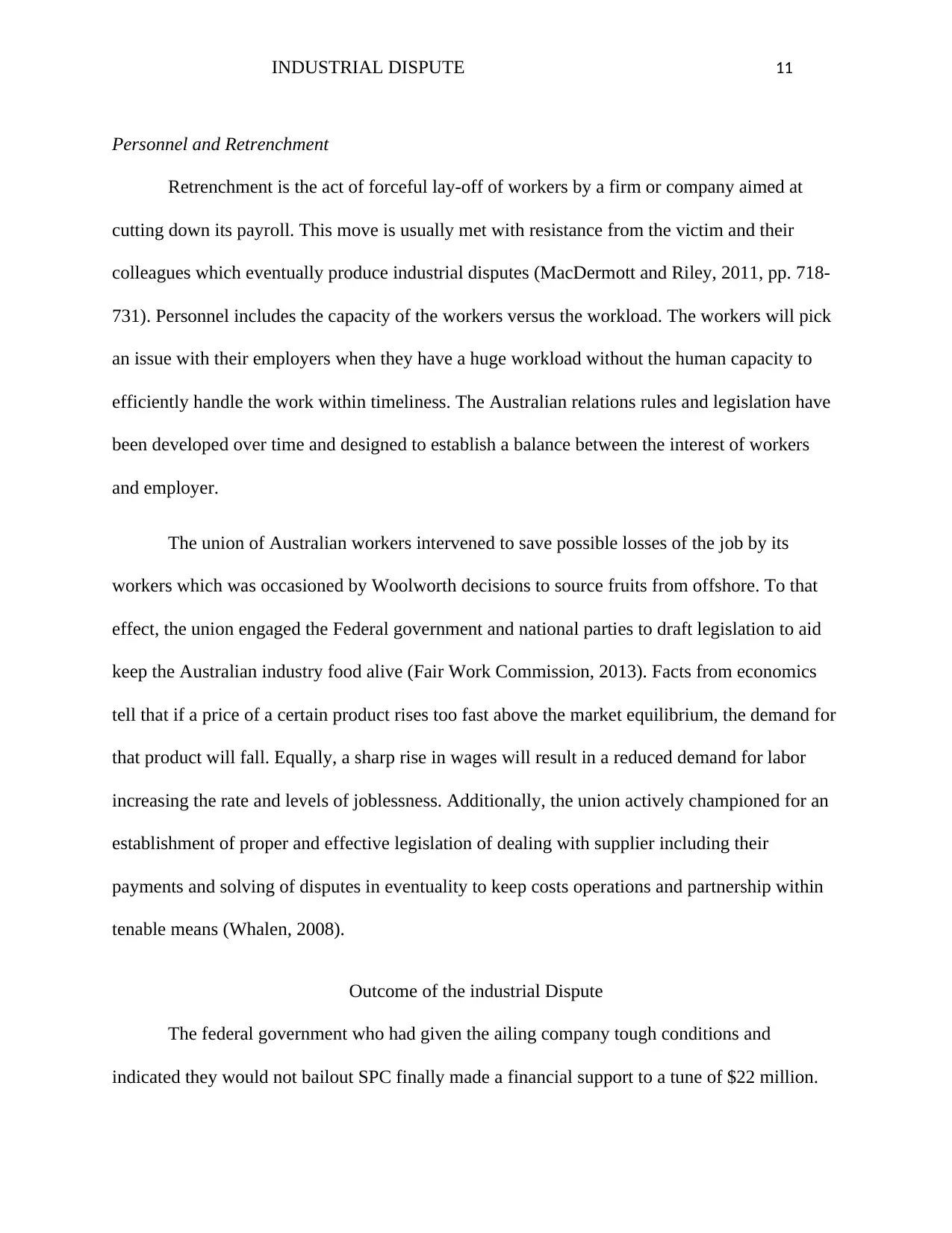
INDUSTRIAL DISPUTE 11
Personnel and Retrenchment
Retrenchment is the act of forceful lay-off of workers by a firm or company aimed at
cutting down its payroll. This move is usually met with resistance from the victim and their
colleagues which eventually produce industrial disputes (MacDermott and Riley, 2011, pp. 718-
731). Personnel includes the capacity of the workers versus the workload. The workers will pick
an issue with their employers when they have a huge workload without the human capacity to
efficiently handle the work within timeliness. The Australian relations rules and legislation have
been developed over time and designed to establish a balance between the interest of workers
and employer.
The union of Australian workers intervened to save possible losses of the job by its
workers which was occasioned by Woolworth decisions to source fruits from offshore. To that
effect, the union engaged the Federal government and national parties to draft legislation to aid
keep the Australian industry food alive (Fair Work Commission, 2013). Facts from economics
tell that if a price of a certain product rises too fast above the market equilibrium, the demand for
that product will fall. Equally, a sharp rise in wages will result in a reduced demand for labor
increasing the rate and levels of joblessness. Additionally, the union actively championed for an
establishment of proper and effective legislation of dealing with supplier including their
payments and solving of disputes in eventuality to keep costs operations and partnership within
tenable means (Whalen, 2008).
Outcome of the industrial Dispute
The federal government who had given the ailing company tough conditions and
indicated they would not bailout SPC finally made a financial support to a tune of $22 million.
Personnel and Retrenchment
Retrenchment is the act of forceful lay-off of workers by a firm or company aimed at
cutting down its payroll. This move is usually met with resistance from the victim and their
colleagues which eventually produce industrial disputes (MacDermott and Riley, 2011, pp. 718-
731). Personnel includes the capacity of the workers versus the workload. The workers will pick
an issue with their employers when they have a huge workload without the human capacity to
efficiently handle the work within timeliness. The Australian relations rules and legislation have
been developed over time and designed to establish a balance between the interest of workers
and employer.
The union of Australian workers intervened to save possible losses of the job by its
workers which was occasioned by Woolworth decisions to source fruits from offshore. To that
effect, the union engaged the Federal government and national parties to draft legislation to aid
keep the Australian industry food alive (Fair Work Commission, 2013). Facts from economics
tell that if a price of a certain product rises too fast above the market equilibrium, the demand for
that product will fall. Equally, a sharp rise in wages will result in a reduced demand for labor
increasing the rate and levels of joblessness. Additionally, the union actively championed for an
establishment of proper and effective legislation of dealing with supplier including their
payments and solving of disputes in eventuality to keep costs operations and partnership within
tenable means (Whalen, 2008).
Outcome of the industrial Dispute
The federal government who had given the ailing company tough conditions and
indicated they would not bailout SPC finally made a financial support to a tune of $22 million.
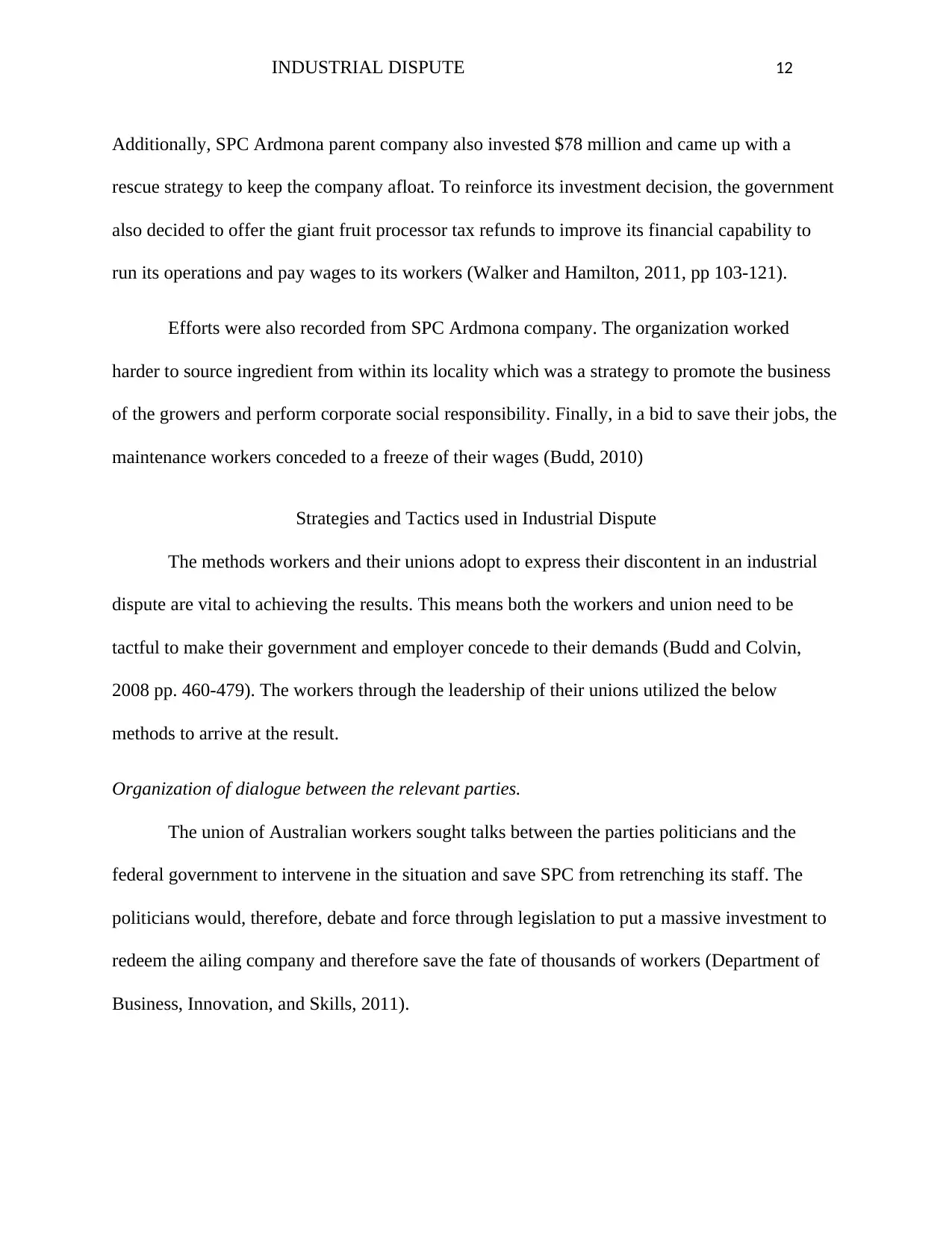
INDUSTRIAL DISPUTE 12
Additionally, SPC Ardmona parent company also invested $78 million and came up with a
rescue strategy to keep the company afloat. To reinforce its investment decision, the government
also decided to offer the giant fruit processor tax refunds to improve its financial capability to
run its operations and pay wages to its workers (Walker and Hamilton, 2011, pp 103-121).
Efforts were also recorded from SPC Ardmona company. The organization worked
harder to source ingredient from within its locality which was a strategy to promote the business
of the growers and perform corporate social responsibility. Finally, in a bid to save their jobs, the
maintenance workers conceded to a freeze of their wages (Budd, 2010)
Strategies and Tactics used in Industrial Dispute
The methods workers and their unions adopt to express their discontent in an industrial
dispute are vital to achieving the results. This means both the workers and union need to be
tactful to make their government and employer concede to their demands (Budd and Colvin,
2008 pp. 460-479). The workers through the leadership of their unions utilized the below
methods to arrive at the result.
Organization of dialogue between the relevant parties.
The union of Australian workers sought talks between the parties politicians and the
federal government to intervene in the situation and save SPC from retrenching its staff. The
politicians would, therefore, debate and force through legislation to put a massive investment to
redeem the ailing company and therefore save the fate of thousands of workers (Department of
Business, Innovation, and Skills, 2011).
Additionally, SPC Ardmona parent company also invested $78 million and came up with a
rescue strategy to keep the company afloat. To reinforce its investment decision, the government
also decided to offer the giant fruit processor tax refunds to improve its financial capability to
run its operations and pay wages to its workers (Walker and Hamilton, 2011, pp 103-121).
Efforts were also recorded from SPC Ardmona company. The organization worked
harder to source ingredient from within its locality which was a strategy to promote the business
of the growers and perform corporate social responsibility. Finally, in a bid to save their jobs, the
maintenance workers conceded to a freeze of their wages (Budd, 2010)
Strategies and Tactics used in Industrial Dispute
The methods workers and their unions adopt to express their discontent in an industrial
dispute are vital to achieving the results. This means both the workers and union need to be
tactful to make their government and employer concede to their demands (Budd and Colvin,
2008 pp. 460-479). The workers through the leadership of their unions utilized the below
methods to arrive at the result.
Organization of dialogue between the relevant parties.
The union of Australian workers sought talks between the parties politicians and the
federal government to intervene in the situation and save SPC from retrenching its staff. The
politicians would, therefore, debate and force through legislation to put a massive investment to
redeem the ailing company and therefore save the fate of thousands of workers (Department of
Business, Innovation, and Skills, 2011).
⊘ This is a preview!⊘
Do you want full access?
Subscribe today to unlock all pages.

Trusted by 1+ million students worldwide
1 out of 18
Your All-in-One AI-Powered Toolkit for Academic Success.
+13062052269
info@desklib.com
Available 24*7 on WhatsApp / Email
![[object Object]](/_next/static/media/star-bottom.7253800d.svg)
Unlock your academic potential
Copyright © 2020–2025 A2Z Services. All Rights Reserved. Developed and managed by ZUCOL.


